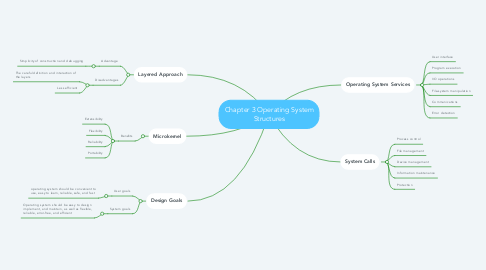Chapter 3 Operating System Structures
LIM HONG SHENにより


1. Operating System Services
1.1. User interface
1.2. Program execution
1.3. I/O operations
1.4. File-system manipulation
1.5. Communications
1.6. Error detection
2. System Calls
2.1. Process control
2.2. File management
2.3. Device management
2.4. Information maintenance
2.5. Protection
3. Layered Approach
3.1. Advantage
3.1.1. Simplicity of construction and debugging
3.2. Disadvantages
3.2.1. The careful definition and interaction of the layers
3.2.2. Less efficient
4. Microkernel
4.1. Benefits
4.1.1. Extensibility
4.1.2. Flexibility
4.1.3. Reliability
4.1.4. Portability
5. Design Goals
5.1. User goals
5.1.1. operating system should be convenient to use, easy to learn, reliable, safe, and fast
5.2. System goals
5.2.1. Operating system should be easy to design implement, and maintain, as well as flexible, reliable, error-free, and efficient

